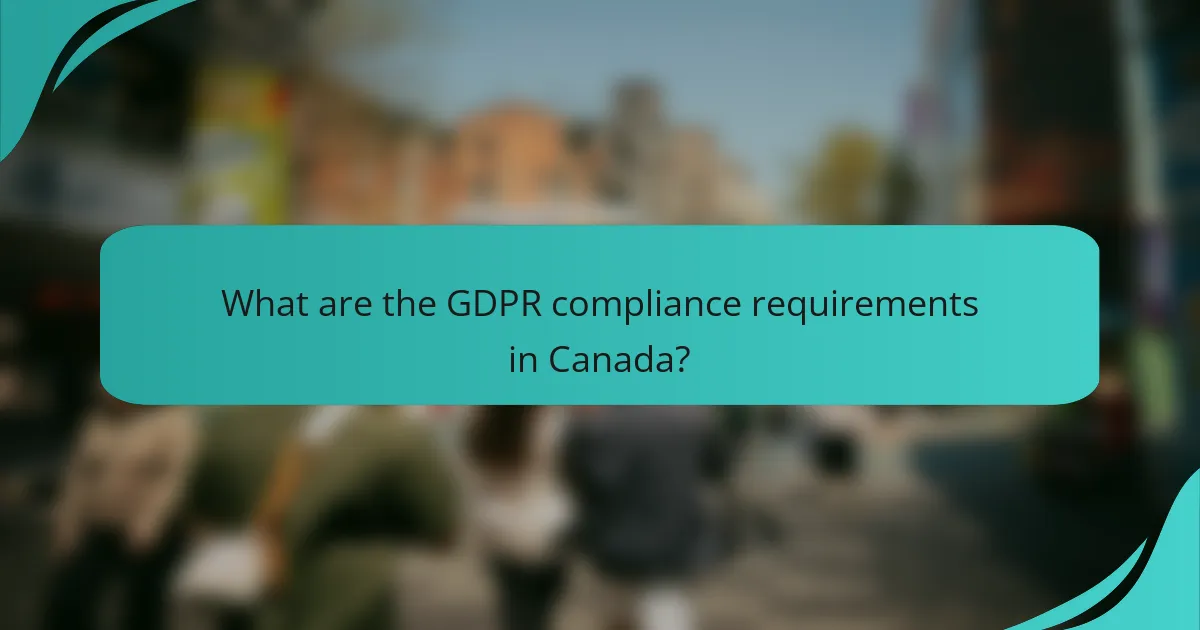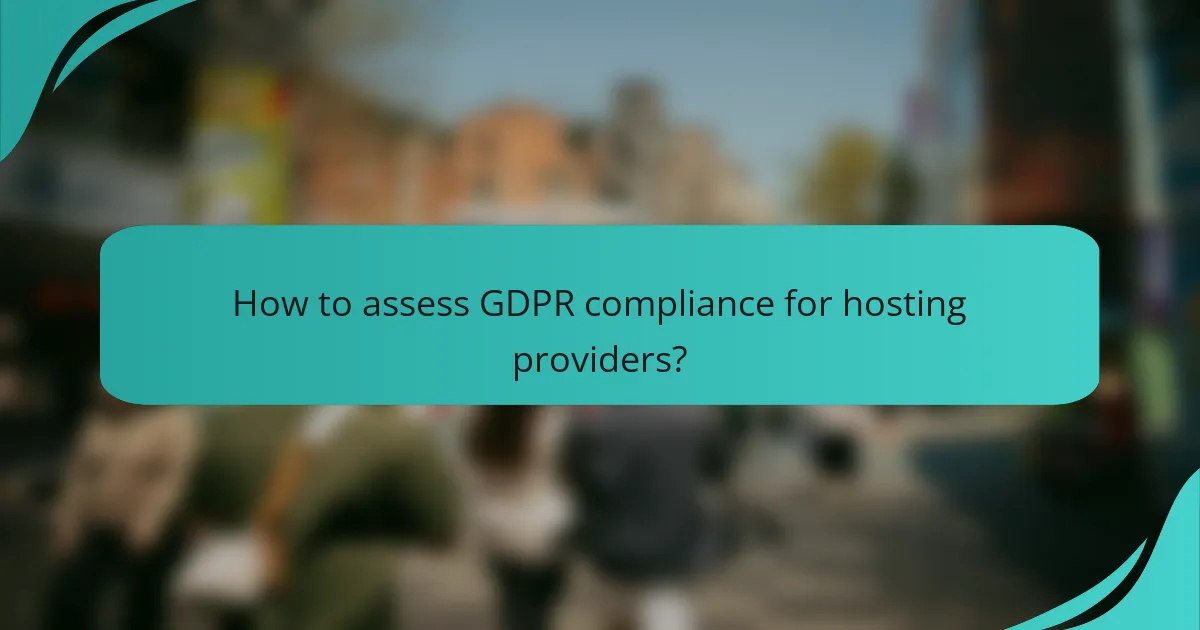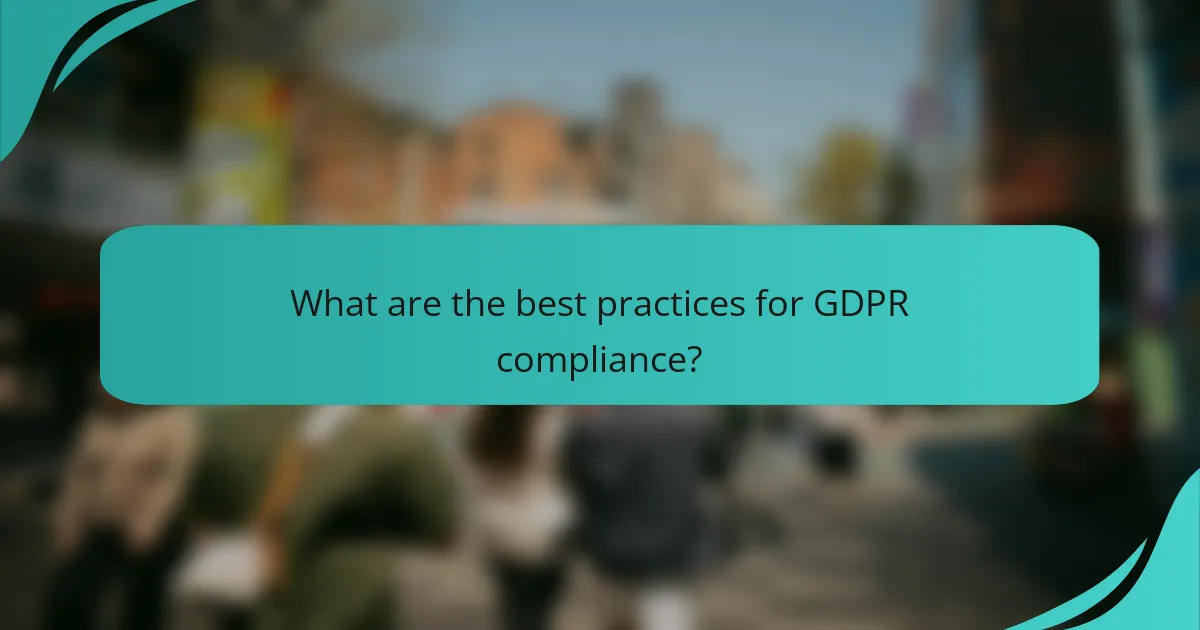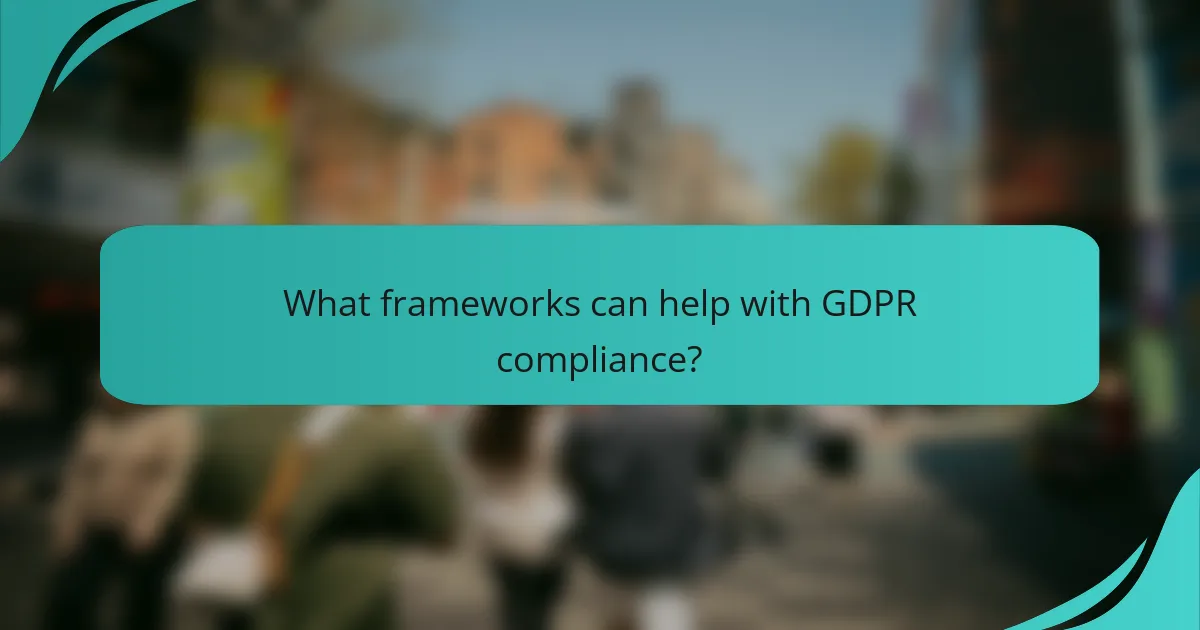GDPR compliance is essential for organizations handling personal data, emphasizing lawful, transparent, and secure processing while safeguarding individual rights. When assessing hosting providers, it is vital to examine their data processing agreements, security protocols, and compliance with third-party regulations. Non-compliance can result in significant financial penalties and reputational damage, making it crucial for businesses to understand the implications of GDPR regulations.

What are the GDPR compliance requirements in Canada?
GDPR compliance in Canada primarily revolves around the protection of personal data and the rights of individuals. Organizations must adhere to principles that ensure data is processed lawfully, transparently, and securely, while also respecting individuals’ rights regarding their personal information.
Data protection principles
The GDPR outlines several key data protection principles that organizations must follow. These include lawfulness, fairness, and transparency in data processing, as well as purpose limitation, data minimization, accuracy, storage limitation, integrity, and confidentiality. Organizations should ensure that personal data is collected for legitimate purposes and that individuals are informed about how their data will be used.
For example, organizations should only collect data necessary for their operations and ensure it is accurate and up-to-date. Regular audits can help maintain compliance with these principles.
Rights of individuals
Individuals have specific rights under GDPR that organizations must respect. These rights include the right to access their personal data, the right to rectify inaccuracies, the right to erasure (often referred to as the right to be forgotten), and the right to data portability. Organizations should implement processes to facilitate these rights effectively.
For instance, a user requesting access to their data should receive a response within a month, and organizations should have clear procedures in place to handle such requests efficiently.
Accountability obligations
Organizations are required to demonstrate accountability for their data processing activities. This means they must implement appropriate technical and organizational measures to ensure compliance with GDPR. Regular training for staff on data protection practices is essential.
Additionally, appointing a Data Protection Officer (DPO) can help organizations manage compliance and act as a point of contact for data subjects and regulatory authorities.
Documentation requirements
GDPR mandates that organizations maintain detailed documentation of their data processing activities. This includes records of processing activities, data protection impact assessments (DPIAs), and evidence of compliance with the data protection principles.
Keeping comprehensive records not only aids in compliance but also provides transparency and accountability, which can be beneficial during audits or investigations.
Data breach notification
In the event of a data breach, organizations must notify the relevant supervisory authority within 72 hours of becoming aware of the breach. If the breach poses a high risk to individuals’ rights and freedoms, affected individuals must also be informed without undue delay.
To prepare for potential breaches, organizations should have an incident response plan in place that outlines the steps to take when a breach occurs, ensuring swift action to mitigate risks and comply with notification requirements.

How to assess GDPR compliance for hosting providers?
To assess GDPR compliance for hosting providers, focus on their data processing agreements, security measures, third-party compliance, and data transfer mechanisms. These elements are crucial in ensuring that your data is handled according to GDPR standards.
Evaluate data processing agreements
Data processing agreements (DPAs) outline the responsibilities of both the hosting provider and the client regarding data handling. Ensure that the DPA includes specific clauses about data protection, processing purposes, and the rights of data subjects.
Look for provisions that detail how the provider will manage personal data, including their obligations in case of a data breach. A well-structured DPA should also specify the duration of data processing and the measures taken to ensure compliance with GDPR.
Check data security measures
Data security measures are essential for protecting personal data from unauthorized access and breaches. Evaluate the hosting provider’s security protocols, such as encryption, access controls, and regular security audits.
Consider whether the provider complies with recognized security standards, such as ISO 27001 or NIST. Regularly updated security measures and incident response plans are indicators of a provider’s commitment to safeguarding data.
Review third-party compliance
Third-party compliance is critical, as hosting providers often rely on subcontractors for various services. Ensure that any third parties involved in data processing also adhere to GDPR requirements.
Request documentation that demonstrates the compliance status of these third parties. This may include their own DPAs, security certifications, and audit reports to confirm they meet GDPR standards.
Assess data transfer mechanisms
When personal data is transferred outside the European Economic Area (EEA), it is vital to ensure that adequate protections are in place. Assess the mechanisms the hosting provider uses for international data transfers, such as Standard Contractual Clauses (SCCs) or Binding Corporate Rules (BCRs).
Be aware of the legal frameworks governing data transfers, such as the Privacy Shield framework, which has been invalidated, making it essential to verify current compliance mechanisms. Ensure that the hosting provider can demonstrate how they maintain GDPR compliance during data transfers.

What are the implications of non-compliance with GDPR?
Non-compliance with GDPR can lead to severe consequences for organizations, including financial penalties, damage to reputation, and potential legal actions. Understanding these implications is crucial for businesses operating within or dealing with the European Union.
Fines and penalties
Organizations that fail to comply with GDPR may face fines that can reach up to 4% of their annual global turnover or €20 million, whichever is higher. These penalties are tiered based on the severity of the violation, with lesser infractions incurring lower fines.
For example, failing to report a data breach within the required 72 hours may result in significant fines. Companies should implement strict data protection measures to avoid these financial repercussions.
Reputational damage
Non-compliance can severely harm a company’s reputation, leading to a loss of customer trust and loyalty. Customers are increasingly aware of their data rights and may choose to take their business elsewhere if they perceive a company as negligent in protecting their personal information.
Moreover, negative publicity from data breaches or compliance failures can have long-lasting effects on brand image, making it essential for businesses to prioritize GDPR compliance as part of their overall strategy.
Legal consequences
In addition to financial penalties, non-compliance with GDPR can lead to legal actions from affected individuals or regulatory bodies. Individuals may seek compensation for damages resulting from data breaches, which can escalate into class-action lawsuits.
Organizations should be aware that regulatory authorities have the power to impose additional sanctions, including restrictions on processing personal data, which can disrupt business operations. Establishing robust compliance frameworks is vital to mitigate these risks.

What are the best practices for GDPR compliance?
Best practices for GDPR compliance involve a combination of proactive measures to protect personal data and ensure transparency with users. Organizations should focus on regular audits, data protection by design, and employee training to maintain compliance and mitigate risks.
Conduct regular audits
Regular audits are essential for assessing GDPR compliance and identifying potential vulnerabilities in data handling practices. Organizations should schedule these audits at least annually, but more frequent assessments may be necessary depending on the volume of data processed and the complexity of operations.
During audits, review data processing activities, consent mechanisms, and security measures. Document findings and create action plans to address any compliance gaps, ensuring that all stakeholders are informed and involved in the process.
Implement data protection by design
Data protection by design means integrating privacy measures into the development of products and services from the outset. This proactive approach helps to minimize risks and ensures that personal data is handled securely throughout its lifecycle.
Consider implementing techniques such as data minimization, encryption, and access controls. For example, only collect data that is necessary for specific purposes, and ensure that sensitive information is encrypted both in transit and at rest.
Train employees on data privacy
Training employees on data privacy is crucial for fostering a culture of compliance within the organization. Regular training sessions should cover GDPR principles, data handling procedures, and the importance of protecting personal information.
Consider using a mix of training methods, such as workshops, online courses, and practical exercises. Encourage employees to ask questions and report any data privacy concerns, reinforcing the idea that everyone plays a role in maintaining compliance.

How does GDPR impact Canadian businesses?
The General Data Protection Regulation (GDPR) significantly affects Canadian businesses that handle the personal data of EU citizens. Compliance requires adherence to strict data protection standards, which can lead to operational adjustments and increased scrutiny over data practices.
Cross-border data flow challenges
GDPR imposes strict regulations on the transfer of personal data outside the EU, which can create challenges for Canadian businesses that operate internationally. Companies must ensure that any data transferred to Canada is protected in a manner that meets GDPR standards, often requiring additional legal agreements or safeguards.
To facilitate compliance, businesses may need to implement Standard Contractual Clauses (SCCs) or ensure that their hosting providers offer adequate protection measures. This can complicate partnerships with non-EU entities and may require ongoing legal consultations.
Increased operational costs
Compliance with GDPR can lead to increased operational costs for Canadian businesses. Companies may need to invest in new technologies, hire data protection officers, or conduct regular audits to ensure adherence to regulations.
Additionally, training staff on GDPR requirements and implementing robust data management practices can further strain budgets. Businesses should consider these costs when planning their data strategies to avoid unexpected financial burdens.
Changes in customer trust
GDPR compliance can enhance customer trust among EU citizens, as it demonstrates a commitment to protecting personal data. Canadian businesses that prioritize data privacy may find that they attract more customers who value transparency and security.
However, failure to comply can lead to reputational damage and loss of trust. Companies should communicate their data protection efforts clearly to customers, reinforcing their commitment to privacy and compliance with international standards.

What frameworks can help with GDPR compliance?
Several frameworks can assist organizations in achieving GDPR compliance, including ISO 27001, NIST Cybersecurity Framework, and the GDPR itself. These frameworks provide guidelines and best practices for data protection, risk management, and privacy governance.
ISO 27001
ISO 27001 is an international standard for information security management systems (ISMS). It outlines a systematic approach to managing sensitive company information, ensuring data security, and protecting privacy. Organizations can implement ISO 27001 to establish a robust framework for managing GDPR compliance.
To achieve certification, companies must conduct a risk assessment, implement security controls, and regularly review their practices. This process can take several months and involves continuous improvement to adapt to evolving threats and regulations.
NIST Cybersecurity Framework
The NIST Cybersecurity Framework provides a policy framework of computer security guidance for how private sector organizations can assess and improve their ability to prevent, detect, and respond to cyber attacks. It consists of five core functions: Identify, Protect, Detect, Respond, and Recover.
By aligning with this framework, organizations can enhance their data protection measures and ensure compliance with GDPR requirements. It is particularly useful for organizations in the United States looking to align their cybersecurity practices with international standards.
GDPR Compliance Checklist
A GDPR compliance checklist can help organizations systematically address the requirements of the regulation. Key items include appointing a Data Protection Officer (DPO), conducting Data Protection Impact Assessments (DPIAs), and ensuring transparent data processing practices.
- Review and update privacy policies.
- Implement data subject rights procedures.
- Ensure secure data storage and processing.
Regular audits and employee training are essential to maintain compliance and adapt to any changes in the regulation or organizational practices.









